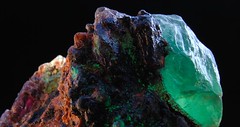 [Mount Gee Fluorite image courtesy Tim Baier - copyright Tim Baier 2008 - click the photo for more information]
[Mount Gee Fluorite image courtesy Tim Baier - copyright Tim Baier 2008 - click the photo for more information]Last Thursday, Greens MLC Mark Parnell asked a series of interesting questions of Mineral Resources Development Minister Paul Holloway in the state's upper house -
...[A]ccording to the final investigation report, on 19 December 2007, Marathon requested the use of two new drill rigs in the sanctuary at Mount Gee so it could fast track its drilling program. In late December (one or two weeks later), PIRSA received the allegations of the inappropriate disposal of waste in pits at Mount Gee from the Leigh Creek police.
The new drill rig request was granted by PIRSA on 10 January 2008, in spite of these outstanding allegations and in spite of the fact that its own team of three, and an EPA team of two inspectors, were due to travel to Arkaroola only five days later on 15 January 2008.
My questions are:
1. Why, given the seriousness of the allegations, was the company granted an opportunity to actually accelerate its drilling program whilst those allegations were unresolved?
2. I refer to the unique fluorite occurrence which was damaged and removed by Marathon employees. I did inspect that site and the remaining fluorite is, in fact, incredibly beautiful. I also understand that it is very rare and very valuable. Where is the fluorite now that was taken, and what actions has PIRSA taken to find that fluorite and to return it to the Arkaroola sanctuary?
3. Will the Minister once and for all confirm that, when the clean up by the company is complete, the Government will finally cancel Marathon's exploration licence?
Let's have a look at the minister's responses -
ANSWER:The Hon. P. HOLLOWAY (Minister for Mineral Resources Development): In relation to the fluorite occurrence, that is referred to in the investigation. If the honourable member has a copy of the report, as he said, I would suggest that he read the detail there. As I understand it, and it is some time since I have read the report, there was obviously some dispute over who had taken this particular fluorite.
Clearly, the expectation would be that it was someone within the company, but who exactly had done it and what had happened to it, of course, was somewhat indeterminate. It would be very difficult to track down exactly what had happened in relation to that, because there are also other people on the Arkaroola site who —
An honourable member interjecting:
The Hon. P. HOLLOWAY: Well, it may have been disturbed, but who actually took it is, of course, another matter. However, I believe that that matter is adequately covered in the report that the honourable member says he has in his possession.
You'll have noticed that the Minister had simply ignored the first question. It remains a very interesting one.
But his reply to the second doesn't leave us much the wiser than his ignoring the first did!
the case of the missing minerals
This PIRSA report that Mark refers to notably begs the question of exactly what happened to the missing chunks of the unique fluorite outcrop, a core of the nationally significant Mount Gee geological monument. This was, of course, the reason he asked the question in the first place!
Geology students all over the country will be keen to know the answer. As PIRSA's final report itself notes'[t]his unique mineral occurrence is well known to Australian geologists and mineralogists.' But in order to further beg the question the minister simply refers back to this same report that doesn't tell us!
He then alludes to the notion that 'other people', presumably with access to the site, might have been responsible for its ultimate disappearance.
This is remarkable! We're not exactly talking a handful of gemstones someone scooped into a lunchbox here! Here's what the report actually says -
Identifiable machinery tracks to the site and an excavated area of approximately 2.5 by 2m at the edge of a creek were recorded and photographed. From the track and excavation impact, it appears that a small excavator had been used to remove a substantial part of this unique fluorite vein occurrence, Mr Newell [from Marathon - BD ] was informed of this matter by PIRSA officers and he subsequently visited the site and confirmed verbally that the site had been accessed by a small excavator. There is no DEF authorisation for Marathon staff to excavate or remove material from this site.
At the site, numerous tracks were observed immediately north and west of the investigation area, outside of designated zones used to access approved drill sites...
The report the goes on to state in its summary of investigation findings -
A Marathon representative inspected the fluorite vein and confirmed that the site had been damaged and had been accessed by mechanical digging equipment. The Marathon representative could not advise as to who damaged the site. Marathon's exploration operations are the only operations within Arkaroola that have this type of equipment available [emphasis mine - BD]. The evidence indicates that the following PIRSA approval conditions for the use of Declared Equipment dated 1 November 2006 have been breached:
A geological monument has been identified as an environmentally sensitive site within your proposed drilling area. The DEF has been circulated to the Geological Monument Subcommittee for comment/information. Comments received are attached below.
(i) The Subcommittee has no objections to the work as outlined in the Marathon Mt Gee DEF. The drilling project should not affect the Mt Gee geological monument FR1.2, as the track maintenance and drill pad work outlined in the DEF are on the east and west slopes of Mt Gee, whereas the quartz sinter, the subject of the monument nomination, is on the upper parts of the hill. [emphasis mine] They should be reminded, however, of the need to avoid any damage to the sinter area, as well as unnecessary damage to other natural outcrops closer to their operations.
The minister's notion that while a Marathon employee may have actually used machinery - which, as the report notes, was only locally available to Marathon's employees, and this excavation was subsequently admitted by the company anyway - to remove a large chunk of a rare mineral, but that 'other people' wandering around in this remote region may have made off with it I leave to the reader to contemplate...
So where exactly is the missing fluorite?
marathon's statement
While the report - which, we must remember, 'adequately covers' the issue according to the minister - doesn't detail Marathon's response to PIRSA, it's left to the company to tell us what they told them, via their own 'Learning from Waste in the Wilderness' document (how sweet and reassuring; the audacity of this would-be-innocuous, saccharine title - given the circumstances of its publication - never ceases to amaze me!) -
Marathon had management at the Mt Gee site that did not properly appreciate the appropriate sustainable development standards. This is exemplified by the damage an employee of Marathon Resources did to a fluorite vein located within the Mt Gee geological monument area. [emphasis mine] He used declared equipment within EL 3258 without written authorisation from PIRSA.
The region in general has a long history of gem and mineral fossicking, however, the actions of one of Marathon’s employees in causing damage to this significant Mt Gee fluorite occurrence was unacceptable. The occurrence is an important educational and research tool for tertiary geology students and a unique Australian environmental monument for Arkaroola Sanctuary’s international tourists.
Following damage to the Fluorite occurrence, Marathon conveyed to PIRSA the following:
‘In relation to Marathon’s involvement at this site, we have found that at some time during February 2007 a quantity of surface material was pulled from a badly eroded watercourse onto the bank with a small backhoe by a Marathon employee. The water course which is up to 1.0m deep and 1.5m wide at an inclination of +/- 14o has been eroded by water flow from a site excavated for exploration purposes by a party prior to Marathon Resources’ involvement on Mt Gee. The quantity of material pulled from the eroded gully is estimated by us as a result of a visit to the site on 12 February 2008 as less than 0.5m2 [sic - and note the variance with PIRSA's 'excavated area of approximately 2.5 by 2m' - BD] or no more than 250kg [! - emphasis mine]. We are advised that when the material was moved from the gully, no sampling took place. The Marathon Resources employee who removed the surface material... was on an activity not authorised by the Company... His action was not in accord with our environmental policy. We are assured that he did not then subsequently remove any samples and has not returned to the location since February 2007. It is evident from ...photographs that subsequent to the event of February 2007 a person or persons (and unknown to Marathon Resources) has/have made a further excavation of approximately 80 litres (4 standard buckets)(letter to PIRSA dated 27 February 2008).
The geological significance of the fluorite occurrence was not explicitly detailed in Marathon’s environmental control documentation. In order to ensure there is no further damage to this, or any other monument, Marathon’s employees need to be aware of the geological significance of the area and how their actions might directly impact on sensitive sites. Further, they need to be accountable for their actions at site level at all times.
So, are we to to assume, then, that this was an instance of 'fossicking'? If Marathon employees are indeed to be held accountable what disciplinary actions have been taken against the one responsible?
And PIRSA is satisfied? Is one admitted excavation by a Marathon employee and a remarkable follow-up effort by 'person or persons... unknown' really as far as investigating this matter can go? And, leaving aside whodunits, where's the stones? We aren't told.
How can Paul Holloway - the responsible minister overseeing a well-known, nationally significant mineral occurrence in a national Geological Monument - rest content with 'but who exactly had done it and what had happened to it, of course, was somewhat indeterminate...'?
Come to think of it, when gems go missing, isn't it usually regarded as a matter for police involvement?
it's OK - they have a plan!
And what's to be done about the damage. PIRSA is on the case -
In relation to the unauthorised sampling and damage to the fluorite occurrence at Mt Gee, the company is requested to consult with the landholders, PIRSA and other stakeholders in the development of a remediation plan for the damaged fluorite occurrence in the Mt Gee Geological Monument Area.
How, precisely, does one 'remediate' the removal of a large chunk of a rare mineral? Particularly given its mysterious apparent absence from the site. Buy some more on EBay? Then use Blu-tac? Superglue? Of course, my suggestions are absurd; but of late, sadly, farce just seems to pile upon farce when it comes to Mount Gee...
a bleak future for miners?
But, what of the overall question? What does the future hold for Mount Gee and the Arkaroola Wilderness Sanctuary? Paul Holloway does have something to say about that -
In relation to the future of drilling at Mount Gee, I have already answered that in an earlier question today, in that the exploration licence remains live until the exploration is finished. As to the future of it, that is something that will have to await until the clean up is finished. When I made my statement I think I mentioned a number of other conditions that Marathon Resources will have to meet before any further exploration will be permitted in that area. One of the obvious ones is its relationship with the landholders. The view I have expressed to any mineral explorer is that, if they do not have good relations with the landholders, the future of mining within those areas is likely to be bleak. [emphasis mine]
Well, it's not exactly the kind of definitive statement we'd all appreciate, but it has substantially more content than the other responses.
I scarcely need to reiterate how fervently the landholders in this instance simply wish the company would pack up all its 'Declared Equipment' and go home!
It's the state government's own legislative deficiencies that have forced the Spriggs into the absurd position of having to countenance this farce in the heart of their sanctuary. This same state government would surely not dare to attempt to pass off Marathon's employing a public relations consultant to deal with the Spriggs (in negotiations they don't want to have in the first place) as 'good' relations?
So this last response cannot bode well for the future for those who hope to mine in the heart of the Arkaroola Wilderness Sanctuary! But Paul Holloway must eventually stop shilly-shallying and publicly declare mining access ended.

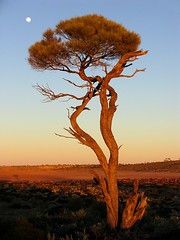

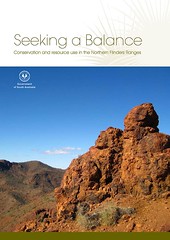
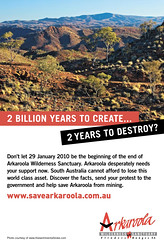
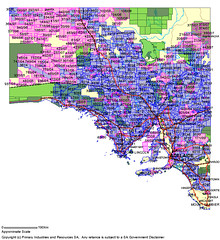
![link to the u[n]sa homepage](http://users.chariot.net.au/~greenh/blog/unknownsa_ublog-text.gif)


![link to the u[n]sa features page](http://users.chariot.net.au/~greenh/blog/features_ublog-text.gif)
![link to the u[n]sa kangaroo island feature image pages](http://farm2.static.flickr.com/1306/1187313059_93fdefd86b_o.jpg)
![link to the u[n]sa katarapko creek / murray river np feature image pages](http://farm2.static.flickr.com/1435/1181073355_b5c45f799d_o.jpg)


!['constellation' - wild country [national] set on flickr](http://farm1.static.flickr.com/155/415123844_3e6da621e5_s.jpg)

!['the bay serene' - the wild west [coast] set on flickr](http://farm1.static.flickr.com/121/312226516_606ac35455_s.jpg)








![u[n]sa journal -thanks for your time! u[n]sa journal - thanks for your time!](http://users.chariot.net.au/~greenh/blog/journal_ublog-text.gif)
Great post Bill. Hope you don't mind, but I've posted it, with acknowledgement, on my blog. Good to see your comment on the Adelaide Now website the other day.. I tried one, but they didn't put it up. The struggle continues...
ReplyDeleteno worries mike -
ReplyDeleteas for the advertiser i was as surprised as anyone that they actually did publish it; believe me, they haven't posted several of mine in the past, too...
still, we can but plug on
Yes it would great if the area is preserved, there are other significant Uranium deposits in the country in less unique and inspiring country. Its very rugged and beautiful in that part of the world.
ReplyDeleteEven if mining would not disturb the visual beauty of Mt Gee (being underground extraction apparently) it is nice to just completely preserve some areas from mining. There would have to be a large tails dam somewhere, large noisy, grubby trucks, blasting and other noise pollution etc. Its probably not going to have the environmental impact that most would have you believe - but why do we need any impact? Why can't we just say NO (or yes) to mining in particular areas, early on and save all the argument and all the public money in wasted investment and save the environmental scars of such wasted mineral exploration if a belated NO verdict is given. My gosh what a silly fiasco this all is.
For example, rather than face real issues both parties are arguing about sideline semantics. Non-issues such as Fluorite theft?? Rare mineral - Fluorite? No, not at all. It is a very common rock forming mineral. Nor is it precious. It is certainly beautiful though and there are several places in the weathered granites of the Flinders Ranges where it can be found. Fossicking or digging of such a Fluorite vein is hardly a loss to the geological heritage of the country.
(Actually Arkaroola has ample evidence of similar such fossicking with all the mineral samples scattered around its grounds - so lets be fair!)
Nice site and good luck with the campaign.
Regards
John
There seems to be a school of thought that holds that 'wisdom' consists of what I think of as 'even-high-handedness'; claiming an omniscience above the fray and adopting a patronising position with regard to both sides.
ReplyDeleteMore foolish mortals are then often chastised for pursuing 'non-issues' that are irrelevant in the purview of the sages.
In this case, the Mount Gee fluorite deposit really is a bona-fide, ridgy-didge Geological Monument and works near it had to be cleared by a committee (who noted specifically that there was no reason for the company to approach it.) Violating it appears to have been seen as non-trivial by some interesting actors, including Marathon itself, and the Minister for Minerals and Energy.
In fact, for the latter, this issue has triggered his effectively perpetually suspending the company's exploration activities (very significant given the lease expiry set for November)
Minister Paul Holloway answering a question from Mark Parnell in his recent speech to the Legislative Council:
"the honourable member... would be aware that some issues arose in relation to the fluorite matter that pointed to some deficiencies within the Mining Act in terms of how these matters might be dealt with.
I will be bringing some amendments into this parliament. Certainly, I would not be contemplating any further activity by Marathon at least and until that legislation was in place, and that might well be some time away..." [emphasis mine]
This isn't some Schrödinger's Cat-like intellectual exercise - mining either happens in Arkaroola, or it does not. One either actively supports it, does something to oppose it, or fails to oppose it, thereby passively endorsing it.
I am certainly not wise enough to be above all this, and that's possibly the reason I expect to shortly be celebrating another victory via active campaign participation; the removal of a third mining company from the Flinders Ranges.
The first was Manna Hill Resources from the Weetootla Gorge (winning fully-protected status for the entire Gammon Ranges National Park in the process), then SAMAG / MgIL from the Beetaloo Valley, and now Marathon from Arkaroola.
There's also the small matter of a half-million hectare Wilderness Protection Area (and mining exclusion zone) in Yellabinna.
In my unsophisticated opinion Marx was right; 'the philosophers have only interpreted the world; the point, however, is to change it.'
I certainly agree that it's 'silly' to start mining in Arkaroola in the first place, and we intend to take up the Minister and SACOME's offer to negotiate drawing up mining no-go zones.
But to my mind one rarely gets into a position to negotiate merely by being clever...